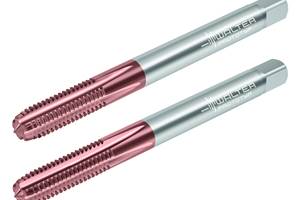More Effective Deep-Hole Drilling with MQL
A dual-margin design enables a series of drills from Nachi to create holes with large length-to-diameter ratios with minimum quantity lubrication.
An increasing number of shops are considering minimum quantity lubrication (MQL). MQL delivers a very small amount of coolant to a cutter’s edge in the form of an oil mist or aerosol, as opposed to traditional techniques of flooding the workpiece and tool with a substantial volume of liquid coolant. The lubricant is mixed with air to form the desired air/oil aerosol mixture, and the aerosol is then sent to the cutting edge through ducts in the tool. Just a tiny bit of that aerosol is left on the chips, workpiece and machine during the cutting operation.
MQL lowers machining costs by eliminating not only the large volume of coolant used in conventional wet operations, but also all the ancillary equipment and electrical power necessary to maintain a big, central coolant system. MQL also creates a cleaner, safer manufacturing environment, which is beneficial to the health of both the equipment used on the shop floor and the employees who work there.
However, when using MQL with conventional long high speed steel (HSS) drills that have a single-margin design, many pecking cycles are commonly needed to provide adequate chip evacuation and stability. Conversely, Nachi’s Aqua EX MQL drills use a dual-margin geometry to enable MQL drilling with length-to-diameter (L/D) ratios ranging to 30:1 without time-consuming retract/re-entry pecking cycles. (Special-order drills can be made in L/D ratios as high as 50:1). The company says these drills are well-suited for creating oil-passage holes for crankshafts, mold cooling holes, and related applications requiring deep, small-diameter holes.
According to the company, the Aqua EX MQL drill’s double margin increases drilling straightness and stability by better controlling drill bending and swelling compared to single-margin designs. In addition, a J-shaped cutting edge with hollow center shape is said to forcibly break up curled chips, while an optimum web diameter offers a balance between chip-removal capability and tool rigidity.
The Aqua EX MQL drills have a TiAlN base plus an AlCrTi nano-layer coating for heat and wear resistance. Additionally, a lubrication film is applied to the top layer of coating to facilitate chip evacuation and limit chip packing. This coating is applied only to the drill tip, which extends the life of the grinding wheel when the drill is reground. (Drills can be reground and re-coated as many as five times.)
A test cut performed by the company shows the performance difference between an Aqua EX MQL drill and a conventional single-margin HSS drill in creating a 5-mm hole to a depth of 100 mm in S53C carbon steel. At a cutting speed of 20 m/min. and feed rate of 150 mm/min., the HSS drill created the hole in 51 seconds and required seven pecking cycles. The Aqua EX MQL drill created the hole in 10 seconds without pecking at a cutting speed of 80 m/min. and feed rate of 750 mm/min.
The Aqua EX MQL drills are available in 10:1 and 15:1 L/D versions in diameters ranging from 1.0 to 12.0 mm. The 20:1 version is available from 1.0 to 10.0 mm; the 25:1 and 30:1 L/D versions range in diameter from 3.0 to 10 mm. The company recommends pre-drilling guide holes to a depth of two to three times the diameter prior to the deep-hole drilling operation.
Related Content
Walter Offers New Solid-Carbide Taps for Blind-Hole Machining
Walter’s TC388 Supreme and TC389 Supreme feature patent-pending cutting geometries that fully shear off the root of the chip when reversing, thus minimizing torque peaks.
Read MoreHow to Tackle Tough Angled Pocket Milling With Two Tools
Milling a deep pocket with a tight corner radius comes with unique challenges, but using both a flat bottom drill and a necked-down finishing tool can help.
Read MoreNew Machining Technology Works With Old to Restore WWII Submarine
A set of donated boring bars that can be used in a 1954 boring head will enable volunteer machinists to recreate a pair of binoculars for the USS Pampanito.
Read MoreNew Modular Tool Options for Small Spindle Milling
Tooling options have been limited for small spindle milling applications. Now modular, indexable systems are available that provide broad flexibility to get the right cutter for the job with less inventory and at lower cost.
Read MoreRead Next
3 Mistakes That Cause CNC Programs to Fail
Despite enhancements to manufacturing technology, there are still issues today that can cause programs to fail. These failures can cause lost time, scrapped parts, damaged machines and even injured operators.
Read MoreThe Cut Scene: The Finer Details of Large-Format Machining
Small details and features can have an outsized impact on large parts, such as Barbco’s collapsible utility drill head.
Read More
.jpg;width=70;height=70;mode=crop)









.png;maxWidth=300;quality=90)















